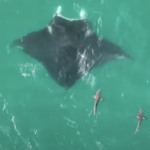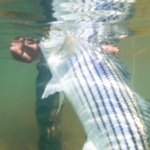
Veteran Florida Guides Concerned About False Albacore
While the ASGA team is extremely proud of the community we’re building with the Guide
Tony Friedrich
VP /Policy Director
Capt John McMurray will do a comprehensive rundown of the striped bass meeting yesterday. Look for that sometime on Sunday. This is a short rundown of what happened and what to prepare for moving forward.
Amendment 7 was approved for public comment yesterday afternoon. For all those who want striped bass on the road to recovery, it was a win. In fact, instead of constantly fending off attempts to weaken management, we can now go on the offense and strengthen core conservation measures.
The final document should be published on the ASMFC’s website shortly. It will conisder issues on Management Triggers, Recreational Release Mortality, Conservation Equivalency, and Rebuilding. We will do a complete review of the final document and our suggestions on how to comment well in advance of the public comment period. Please be on the lookout for that in the next few weeks.
You may recall that there was one other option in the draft document and that was protecting certain year classes. That option was removed as per the recommendation of the Plan Development Team.

Management Triggers
This is a very complicated section, and this blog is intended to be as simple as possible. Our biggest concern with this topic was the opportunity to weaken the triggers. This could be done by changing a trigger timeline from, let’s say, one to three years. That is exactly what Section 4.1: Management Triggers, sub-options B3 in Tier 1: Fishing mortality Management Triggers would have done. It would have moved the trigger from a single year of overfishing to a running 3-year average. Megan Ware (ME) made a motion to remove this option. It was seconded by our own John McMurray and passed by a vote of 10-6. This is excellent news and a win for conservation. Nothing else was removed from the draft amendment. For all of us who want swift action, this is a huge step forward in striped bass management.
Conservation Equivalency (CE)
If you have read anything we wrote in the last three years, you know we are not big fans of CE. It isn’t the concept that we don’t like. It is the lack of accountability when it is abused. This section of the amendment is something we have been waiting a long time to see.
Here we go!


That’s right folks! The Amendment has options to restrict the use of CE if the stock is overfished, below target, or if overfishing is occurring. The second slide, Options C and D, shows that we also have a chance to restrict the MRIP numbers (i.e., require more precise data) used for CE as well as put a “luxury tax” on those jurisdictions that opt-in to CE in the form of an “uncertainty buffer”. This means that if D1 is implemented and a coastwide reduction of 10% was needed, states using CE would have an additional 10% reduction placed on them to account for the uncertainty surrounding CE. Hope that makes sense. In the most simple terms, CE isn’t so attractive anymore for the chronic abusers.
This is where we can improve striped bass management instead of defend status quo. Of course, striped bass need all of you to comment to accomplish this, but hey, it is actually on the table. So, thanks from all of us at ASGA for your commitment. If anyone believes commenting doesn’t matter, show them these slides. You all did something great for stripers. Be very proud!
Recreational Release Mortality

Striped Bass are primarily a recreational fishery. By a huge percentage, recreational anglers have chosen to release most striped bass they land. Because of this, release mortality is a large component of overall mortality. 9% of releases are counted as dead fish. When you release around 90% of the fish landed, that can be a big number. We have already implemented circle hooks to aid in mortality associated with bait fishing. There are some other options on the table that we need to understand.
Option B is intended to control fishing effort. That means seasonal closures which could involve either no harvest or no targeting. Drilling down to another level, a harvest and targeting closure could be for spawning areas or general times/areas specified by each state.
ASGA echoes the concerns of law enforcement and several Commissioners that no targeting closures are impossible to enforce and difficult to quantify. We are also concerned that the Amendment does not include clearly defined boundaries or maps for the spawning area closure alternatives. Without maps that define these closures, we are unable to comment further. Hopefully, the maps will be well defined in the final document once it is released.
Rebuilding the Stock
This is what we all care the most about! It is also the area that was altered the most during the meeting. The ASMFC’s clock started ticking on a 10-year rebuilding timeline in 2019 when the board accepted the 2018 stock assessment. That means by 2029, the stock must be rebuilt. Unfortunately, we only addressed the rate of fishing mortality through Addendum VI in 2019. Now, we are under the gun with only six years left to rebuild. Here’s a flow chart of what will happen after the stock assessment comes out in October of 2022.

If Amendment 7 measures will rebuild the stock by 2029, we won’t have to change a thing. Most of us have some serious doubts that this stock assessment will be good news for striped bass. If the Amendment 7 measures will not be enough to rebuild by 2029, the right side of the chart will apply.
This is where it gets a little complicated but please hang with us. If Amendment 7 does not meet the goal of rebuilding by 2029, we would have to develop an addendum to Amendment 7 sometime in 2023. That would mean that we would not start implementing rebuilding until likely 2024. That would leave us only five years to do what we could have done in 10.
Enter Mike Armstrong from Massachusetts. Mike has been a level-headed voice for conservation throughout the years. He solidified that legacy with this motion.

Commissioner Armstrong added an option to the rebuilding section that passed by consent. This motion would empower the Board to use a specification process rather than a full addendum this one time. This means that if Amendment 7 does not adequately rebuild by 2029, the board will have the authority to adjust measures in 2022 rather than wait until 2023. The only downside in this motion is that there will be no time allotted for formal public comment.
That doesn’t mean that we can’t participate by sending letters or contacting Commissioners. However, it does mean that there will not be the normal process of hearings. It is a tradeoff. We can address the problem faster but we will also lose the ability to go through an addendum. At first glance, we are grateful that Commissioner Armstrong made this motion. He recognized the public’s desire to start rebuilding as soon as possible. That is another huge indicator that your effort during the PID process made a huge impact.
Final Take
This meeting could have gone far worse. I hesitate to jump up and down in celebration. What can I say? Maybe I have been burned one too many times? We now have a chance to actually improve striped bass management by modifying CE, accelerating the rebuilding plan, and strengthening management triggers. This is a rare opportunity that we must capitalize upon. If we can generate the same level of public comments, we can bring this iconic species back. This is a once in a lifetime chance to make a difference. The path forward is open. We need to make one final push. For the first time in a very long time, we are in a good position. Let’s all rally and push this one over the line.
John’s blog will be out on Monday or Tuesday. We will also have our commenting guide out as soon as we can. We will do videos. We will hold meetings. We will leave no stone unturned.
We offer all of you a big, heart-felt thanks. Without you, we would be in a far worse position.

While the ASGA team is extremely proud of the community we’re building with the Guide

Feature Image: A false albacore being landed off Jupiter Florida by the Cheeky Fishing team,

Feature Photo: “Best Practices for Fishing Cobia Around Manta Rays” The Florida Manta Project is

We caught this article a few days ago. Here’s the summary: Maryland striped bass commercial
We rely on our members and donations to keep fighting for a sustainable tomorrow in marine conservation.
By using this website, you agree to our use of cookies. We use cookies to provide you with a great experience and to help our website run effectively. To learn more, please review our privacy policy.